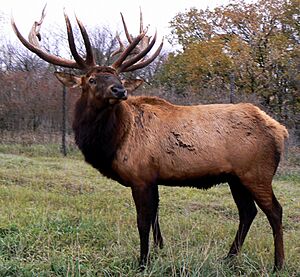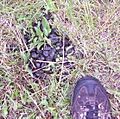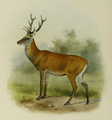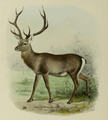Wapiti facts for kids
The Wapiti or elk (Cervus canadensis) is a large and powerful type of deer. These amazing animals live in North America and eastern Asia. They are known for their impressive size and the large antlers grown by the males. Wapiti are important animals in their ecosystems, helping to shape the landscapes where they live.
Contents
What is a Wapiti?
Wapiti are one of the biggest land mammals in North America and East Asia. They are part of the deer family. The word "wapiti" comes from a Native American word meaning "white rump." This describes the light-colored patch on their rear end.
Size and Appearance
Wapiti are very large animals. Adult males, called bulls, can weigh over 700 pounds (320 kg). They can stand up to 5 feet (1.5 meters) tall at the shoulder. Females, called cows, are a bit smaller.
Bulls grow huge antlers every year. These antlers can spread up to 4 feet (1.2 meters) wide. They start growing in spring and are fully grown by late summer. Bulls use their antlers to fight other males during mating season. They shed their antlers in late winter or early spring.
Where They Live
Wapiti live in many different places. They can be found in forests, mountains, and open grasslands. In North America, they live from the Rocky Mountains to the Pacific coast. In Asia, they live in areas like Siberia and China.
Many wapiti herds migrate, meaning they move from one place to another. They often spend summers in high mountain areas. When winter comes, they move down to lower, warmer valleys. This helps them find food and avoid deep snow.
Life of a Wapiti
Wapiti are herbivores, which means they only eat plants. They spend a lot of their time grazing and browsing.
What They Eat
Their diet changes with the seasons. In summer, they eat lots of fresh grasses, leaves, and wildflowers. They also eat bark and twigs from trees and shrubs, especially in winter. Wapiti are important for their environment because they help spread plant seeds.
Sounds and Social Life
Wapiti are very social animals. They often live in herds. Female wapiti and their young usually stay together in large groups. Male wapiti often form smaller groups or live alone.
One of the most famous sounds a bull wapiti makes is called a "bugle." This is a loud, high-pitched call that ends in a series of grunts. Bulls bugle to attract females and to challenge other males during the mating season.
Reproduction and Calves
The mating season for wapiti is in the fall, usually in September and October. This time is called the "rut." Bulls compete fiercely for the chance to mate with females. They will bugle, spar with their antlers, and sometimes even fight.
After about 8 to 9 months, a female wapiti gives birth to one calf. This usually happens in late spring or early summer. The calf is born with spots, which help it blend in with its surroundings. It can stand and walk soon after birth. The mother hides her calf for the first few weeks to protect it from predators. Calves drink their mother's milk and stay with her for about a year.
Facing Danger
Wapiti have natural predators. In North America, their main predators are wolves, cougars, and bears. These predators often target young, old, or sick wapiti. Wapiti use their keen senses of smell and hearing to detect danger. They can also run very fast to escape.
Humans also hunt wapiti. Hunting is often managed to keep wapiti populations healthy.
Images for kids
-
Elk crossing a rock face at Mammoth Hot Springs, Yellowstone National Park
-
Sparring bull elks in Banff National Park, Canada
-
Bull elk on a captive range in Nebraska. These elk, originally from Rocky Mountain herds, exhibit modified behavior due to having been held in captivity.
-
A Kiowa couple. The woman on the right is wearing an elk tooth dress.
See also
 In Spanish: Uapití para niños
In Spanish: Uapití para niños


















